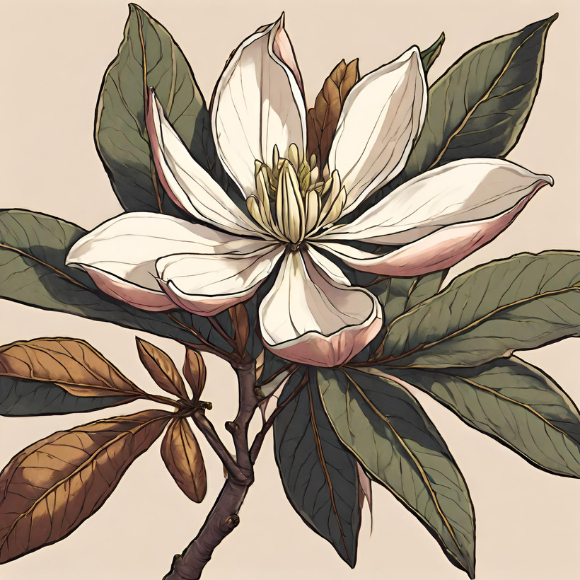
Overview
The Anise Magnolia, scientifically known as Magnolia salicifolia, is a charming deciduous shrub that belongs to the Magnoliaceae family. Also commonly referred to as the Willow-Leaf Magnolia, it is prized for its graceful, narrow leaves, fragrant flowers, and a unique anise-like scent that permeates the air when in bloom. This plant profile will provide insights into the specific soil, sun, and watering requirements, as well as the optimal hardiness zones for cultivating the Anise Magnolia.
Description
Foliage: The Anise Magnolia boasts willow-shaped leaves that are narrow, elongated, and dark green. These leaves add an elegant texture to the garden even when the plant is not in bloom.
Flowers: In early Spring, before the leaves fully emerge, the Anise Magnolia produces exquisite, pendulous, creamy-white flowers with a subtle hint of pale pink or lavender at the base. The blooms are known for their pleasant fragrance, reminiscent of anise or licorice.
Size: Typically a large shrub, the Anise Magnolia can reach heights of 10 to 15 feet and can spread out to a similar width, creating a rounded and gracefully arching form.
Soil Requirements: Anise Magnolias thrive in well-draining, organically rich soil. The ideal soil pH for these magnolias ranges from slightly acidic to neutral, typically between 5.5 and 7.0. While they are adaptable to a variety of soil types, including loam and sandy soils, they tend to perform best in soils that retain moisture without becoming waterlogged.
Sun Requirements: Anise Magnolias flourish in partial to full sun. Providing them with at least four to six hours of direct sunlight each day encourages robust growth and profuse flowering. While they can tolerate partial shade, it is essential to strike a balance to ensure they receive enough sunlight for optimal development and blooming.
Watering Needs: Moderate and consistent moisture is crucial for the health of Anise Magnolias, especially during the growing season and periods of drought. It is recommended to water the plants deeply, allowing the soil to remain consistently moist but not waterlogged. Applying a layer of mulch around the base helps in retaining soil moisture and regulating temperature, contributing to overall plant health.
Hardiness Zones: The Anise Magnolia is well-suited for cultivation in USDA hardiness zones 5 to 9. These zones encompass a broad range of climates, from cooler temperate regions to warmer subtropical areas. This adaptability makes Anise Magnolias versatile choices for a variety of landscapes, allowing gardeners in different regions to enjoy the beauty and fragrance of these distinctive magnolias.
Zone 5: Anise Magnolias may require additional protection in harsh Winters, such as mulching around the base to insulate the roots from extreme cold.
Zones 6-9: Anise Magnolias thrive in these zones, provided they receive the appropriate care regarding soil, sunlight, and water requirements.
Maintenance
Pruning: While Anise Magnolias generally have a natural, attractive shape, occasional pruning can help maintain their form and remove any dead or damaged branches. Pruning is best done immediately after flowering to avoid interfering with the next season’s bloom.
Fertilization: Anise Magnolias benefit from a balanced, slow-release fertilizer applied in Spring. This helps support healthy growth and vibrant blooms.
Pest and Disease Management: These magnolias are relatively resistant to pests and diseases. However, proper sanitation practices and routine checks for aphids and scale insects contribute to the overall well-being of the plant.
The Anise Magnolia, with its slender leaves, fragrant blossoms, and adaptable nature, adds a touch of sophistication and olfactory delight to gardens across a range of hardiness zones. By understanding and meeting its specific soil, sun, and watering requirements, gardeners can cultivate a thriving Anise Magnolia that not only enhances the beauty of the landscape but also creates a sensory haven with its enchanting fragrance.


 Previous
Previous

